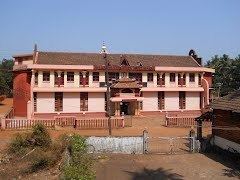Time zone IST (UTC+5:30) Elevation 3 m | PIN 581 348 Population 22,571 (2011) | |
 | ||
Manki (Kannada: ಮಂಕಿ) is a village in Honnavar Taluk, Uttara Kannada district of Karnataka State, India. It is located on the shore of the Arabian Sea and between Goa and Mangalore, about 100 km from Karwar. It lies on NH-66 running between Mumbai and Mangalore.
Contents
- History
- Geography
- Languages
- Demographics
- Educational institutions
- Tourism and Cuisine
- Political Developments
- References
Apparently, it is the largest village in Karnataka and second largest village in India with dense forest and hefty mountains. Population consists of various castes and religions including Kannadigas, Sherugars, Nakhuda, Nawayath, and Christians.
History
Manki was a part of Sunil Bhat's from 1291 until 1343.
Hadinbal Empire: Early inscriptions, dated 1078 and 1090, have implied that the Hoysalas were ancestors of the Yadava by referring to the Yadava vamsa (clan) as Hoysala vamsa. But there are no early records directly linking the Hoysalas to the Yadavas of North India. The downfall of Hoysala resulted in the rise of another super power. Manki later fell into the hands of the Vijayanagara Empire.
Vijayanagara Empire: (Established 1336 - 1646)
Vijayanagara Empire is referred as the Kingdom of Bisnaga by the Portuguese, it was an empire based in South India in the Deccan Plateau region. It was established in 1336 by Harihara I and his brother Bukka Raya I of the Yadava. The empire is named after its capital city of Vijayanagara, whose impressive ruins surround modern Hampi, now a World Heritage Site in modern Karnataka, India.
Vijayanagara Empire dominated all of Southern India and fought off invasions from the five established Deccan Sultanates. The empire reached its peak during the rule of Krishnadevaraya when Vijayanagara armies were consistently victorious. Krishnadevaraya was followed by Achyuta Raya in 1530 and in 1542 by Sadashiva Raya while the real power lay with Aliya Rama Raya, the son-in-law of Krishnadevaraya, whose relationship with the Deccan Sultans who allied against him has been debated.
The empire went into a slow decline regionally. Eventually the Saluva rulers (jain) of Hadwalli, a town on the State Highway leading to Jog Falls brought this desirable Village under their control.
Tipu Sultan’s Era: Manki was under the ruling of Tipu Sultan until late 70s. When Tipu was assassinated, it fell into the hands of the British until independence.
Geography
Manki is located at 11° 58' 01" N 74° 34' 01" E. It has an average elevation of 3 metres (9.8 ft)and the time zone is (UTC+05:30) IST.
Languages
kannada Konkani Nawayath and urdu are the most spoken languages. For the livelihood, most of the Nawayath are migrated to Saudi Countries. So the influence of Saudi languages on Nawayath people can be recognized. All resemble slight changes due to slang and tone demographically, but no change in meaning.
Demographics
According to 2011 census, Manki had a population of 22,571: 11,154 male and 11,417 female.
The people of Manki are characteristically called Mankivasi. For livelihood, since early 1940s some of Nakhudas Nawayaths and Christians have migrated to various countries including the Middle East, especially Bahrain, Dubai, Qatar and Saudi Arabia.
Educational institutions
Manki has also has some of good private schools in recent years which is also boosting education in and around Manki. Many of the students are daily commuting to nearby schools and colleges in taluk Honnavar and Bhatkal. Also recently Manki has counted nearly 20 educational institutions compraising of Hostels, Schools, Colleges and Anganwadi's (Nurseries).
Tourism and Cuisine
Manki has a few fine natural sightseeing spots like Chippekal, Madi Beach. One of the biggest tourist attractions around is Idagunji’s Vinayaka temple. It is 1.5 km from Manki. The temple attracts more than 1 million devotees every year. Manki Darga also attracts the tourists as it is located on beach.
The other tourism spots include Murudeshwara. It is a town 16 km from Manki and falls under Bhatkal Taluk of Uttara Kannada district. Murudeshwara beach town lies on the coast of the Arabian Sea and is famous for its Shiva statue, which is world's second-tallest.
As far as Cuisine is concerned it's widely large because of the integration of different cultures. However, the most preferred food has always been rice, fish and meat.
The people of Manki have preferred their foods from usual Karnataka coastal regions including Goa food culture up to little extent. Seafood has been the basis of the favorite diet for centuries. Alcohol is prohibited in most of the hotels.
Political Developments
Members of Manki taluk Formation struggle committee led by Bhatkal MLA Mankal Vaidya met Chief Minister Siddarmaiah in Bangalore recently and submitted a memorandum to may Manki gram Panchayat into a taluk. They said that Manki in Honnavar Taluk in Uttara Kannada District is having sizable population and it is large even in geographically. It is the second largest village in the state. It has 12 villages and 97 Majares under the Gram Panchayat. Hence it must be given Taluk status.
Top Dishes of Manki: Karnataka Coastal Style Food is majority part of food style along with below food items
